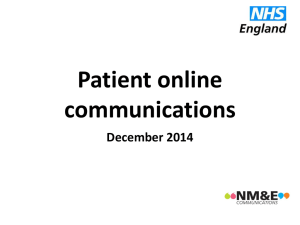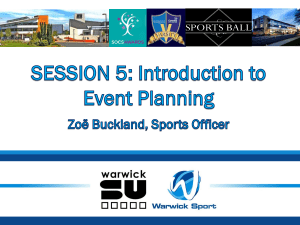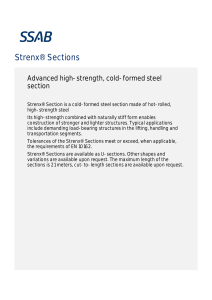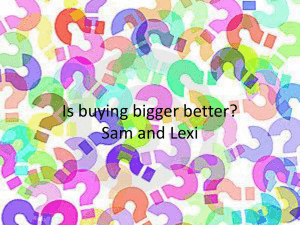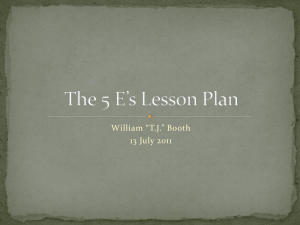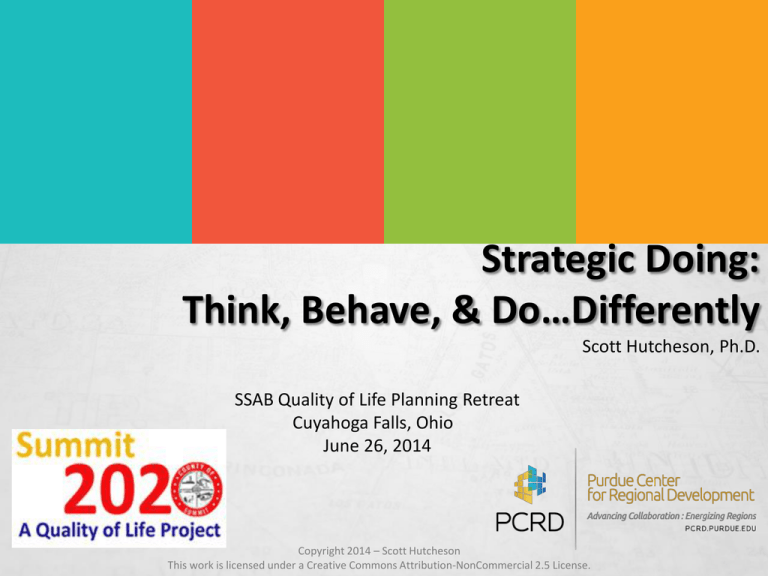
Strategic Doing:
Think, Behave, & Do…Differently
Scott Hutcheson, Ph.D.
SSAB Quality of Life Planning Retreat
Cuyahoga Falls, Ohio
June 26, 2014
Copyright 2014 – Scott Hutcheson
This work is licensed under a Creative Commons Attribution-NonCommercial 2.5 License.
Strategic Doing enables people to form actionoriented collaborations quickly, move them
toward measurable outcomes, and make
adjustments along the way.
Strategy Doing
Leverages the
Value of a
Network
10 nodes, 9 connections
10 nodes, 45 connections
Strategic Doing Accelerates Collaboration
Trust
Co-Creation
Co-Execution
Turf
Sharing
Resources
Sharing
Information
Mutual
Awareness
Acknowledgment
Exploration
Cooperation
Collaboration
Innovation
TIME
Adapted from Collaboration Continuum from ACT for Youth
Strategy
Answers Two
Basic Questions
Strategic Doing Divides the Two Basic Questions into
Four Appreciative Questions
10
Strategic Doing Moves from the
Linear to the Agile
Strategic Doing Is Iterative & Ongoing
Addressing
Community
Quality of Life
Issues
• Think about community quality of life issues
differently
• Accelerate the collaborations needed to
address them
• Create and guide agile, asset-based
strategic action plans to meet a progressive
series of clearly defined objectives
Addressing
Community
Quality of Life
Issues
• Think about community quality of life issues
differently
• Accelerate the collaborations needed to
address them
• Create and guide agile, asset-based
strategic action plans to meet a progressive
series of clearly defined objectives
Practicing Strategic Doing
15
Strategic Doing Pack
What
COULD
SSAB Quality of Life Planning Retreat
we do
together?
June 26, 2014
What’s
your
Our Framing Question:
What
SHOULD
30/30?
we do
together?
What
WILL
Our Knowledge Keeper Name and e-mail:
Our Table Guide name and e-mail:
_
we do
together?
Table of Contents
Section
Explanation
Page
Group Assets
Identify assets we are willing to share
Page 2
What Could we do together?
Brainstorm how we might connect our assets
Page 3
What Could we do together?
Connect assets and define 1-3 new opportunities
Page 4
What Should we do together?
Select 1 opportunity & define a successful outcome
Page 5
What Will we do together?
Define a Pathway project and action plan to get us to our outcome
Page 6
What Will we do together?
Map our successful Outcome, a Pathway Project and key next steps
Page 7
What’s our 30/30?
Define a process moving forward
Page 8
Participant List
Sign-in sheet – tear off to pass, reattach to the pack after completed
Page 9
Copyright © 2014, Purdue University, all rights reserved
Framing
Community
Conversations
Reframing Quality of Life Issues Appreciatively
We have the highest childhood obesity
rates in the state.
18
Reframing Quality of Life Issues Appreciatively
We have the highest childhood obesity
rates in the state.
BECOMES
19
Reframing Quality of Life Issues Appreciatively
We have the highest childhood obesity
rates in the state.
BECOMES
What would it look like if our community was a
place where every child had the support they need
to maintain a healthy weight?
20
• Clinical Care
Develop • Socio-Economic Factors
Appreciative • Physical Environment
Questions
• Health Behaviors
Strategic Doing Pack
What
COULD
SSAB Quality of Life Planning Retreat
we do
together?
June 26, 2014
What’s
your
Our Framing Question:
What
SHOULD
30/30?
we do
together?
What
WILL
Our Knowledge Keeper Name and e-mail:
Our Table Guide name and e-mail:
_
we do
together?
Table of Contents
Section
Explanation
Page
Group Assets
Identify assets we are willing to share
Page 2
What Could we do together?
Brainstorm how we might connect our assets
Page 3
What Could we do together?
Connect assets and define 1-3 new opportunities
Page 4
What Should we do together?
Select 1 opportunity & define a successful outcome
Page 5
What Will we do together?
Define a Pathway project and action plan to get us to our outcome
Page 6
What Will we do together?
Map our successful Outcome, a Pathway Project and key next steps
Page 7
What’s our 30/30?
Define a process moving forward
Page 8
Participant List
Sign-in sheet – tear off to pass, reattach to the pack after completed
Page 9
Copyright © 2014, Purdue University, all rights reserved
Strategic Doing Question 1: What
could we do together?
Introduce yourselves by describing 1-2 assets you are willing to share in a new network
Identify the assets
Everyone should outline 1-2 assets they are willing to share.
Assets can be tangible (places to meet, money, Internet resources, and so on) or intangible (knowledge, experience, networks, passions). Focus your
conversation not so much on what people do, but on what they are willing to share to a new network. Listen carefully for what people are willing to share
and how connections using these assets might be built.
Examples: Bill K – connected to young professionals; Jane S -- skill of
conducting surveys; Susan D. – social networking skills; Bob S – understanding of
City government
Name
Assets
Use the next page to connect the assets to create new opportunities.
2
Strategic Doing Question 1: What
could we do together?
Connect the assets you shared to create new opportunities.
Brainstorming and Notes
Quickly jot down connections that spring up from the discussion. Ask questions like ‘what would that look like‘ or ‘what
if we…..’.
Example of an opportunity connecting these assets:
Bill K – connected to young professionals; Jane S – skill of conducting surveys; Susan D. – social networking skills; ;Bob S –
understanding City government
“We could use Jane’s and Bob’s knowledge and skills to create an online survey of ideas for connecting young adults to government . We
can use Bill’s connection to young professionals to know who to survey and Susan’s social networking skills to survey online and thru
venues such as Facebook and Twitter.”
Use the next page to narrow your ideas to 3 opportunities
2
4
Strategic Doing Question 1: What
could we do together?
Describe up to 3 opportunities
Narrow your ideas from the brainstorming phase to 3 the top choices
that connect the assets
How could you describe this opportunity in one or
two phrases?
Example: Start an initiative to introduce young people to city
government
Opportunity 1:
Opportunity 2:
Opportunity 3:
Use the next page to convert one opportunity to an outcome
2
5
Strategic Doing Question 2: What
should we do together?
Select ONE opportunity & define success
Pick one of your opportunities and covert it to an outcome by defining measurable success
Example: Our Opportunity: Connecting our assets could lead us to an open innovation “hack” for Government 2.0
Our Outcome: An engaged community of at least 20 volunteers who produce new prototypes for government services and launch at least one
redesigned service by 2015.
Success characteristic 1: Engaged city government volunteers
Metric: Number of volunteers
Success characteristic 2: Young adults enrolled in the introduction course
Metric: Number of young adults
participating
Success characteristic 3: At least one service project with the groups within a year
Metric: One service project launched
Our Outcome:
How will you know if you’re successful? Hint:
If you cannot figure out how to measure, the
initiative is too vague to be useful.
Characteristic 1:
Measurement:
Characteristic 2:
Measurement:
Characteristic 3:
Measurement:
Use the next page to design a pathway to your outcome
2
7
will
Strategic Doing Question 3: What
we do together?
Name one “pathfinder” project that can get you to your outcome, then fill out the action steps in your project
Our Pathfinder Project:
1.
Milestone 1: By
we will
Milestone 2: By
we will
2.
3.
Milestone 3: By
we will
Define a Pathfinder Project (a pathway that
moves you to your outcome)
Define the pathway with 2-3 milestones
(key steps that are critical to your success,
so you know you are not getting lost)
Define an action plan for the next 30-90
days.
Our Action Plan for the next 30-90 days
Who
Action Step
By When
2
8
Strategic Doing Question 3: What
will we do together?
Map your outcome and project
Our Outcome.— (Where we are going):
Our Outcome or Success metrics.— (How we know we
have arrived):
1.
2.
3.
Our Pathfinder Project.— (How we will get there):
Milestones along our way.— (To make sure we are not
lost):
Our Key Action Steps to get started.— (What we will start
doing by next week):
1.
2.
3.
4.
2
9
Strategic Doing Question 4: What’s our
30/30?
Moving Forward
Maintaining alignments and connections is a dynamic process requiring
continuous (but not constant) attention.
What’s been done in the last 30 days? What needs to happen in the next 30 ?
Small amounts of time (1-2 hours per month) can be devoted to revising our
strategy. The point is to come back together share what we have learned,
realign ourselves, and figure out our next steps for the next 30 days.
Follow-up Meeting (Sample)
Date
Dec 1
Time
2:00PM
Place
Conference call: Susan will arrange
Follow-up Meeting
Date
Internet Details
How will you use the Internet to stay
connected?
We’ll use e-mail for now. Might focus on
a group blog. Bill will explore.
Internet Details
How will you use the Internet to stay
connected?
Time
Place
3
0
Strategic Doing Pack: SSAB
The first step in a Strategic Doing workshop involves capturing the names and contact information of all the people
around the table. Please pass around this sheet of the Master Pack, so that everyone can sign their name. Give this
to the Table Guide or Knowledge Keeper and attach to the Master Strategic Doing Pack.
Name
Organization
E-mail
Materials developed by the Purdue Center for Regional Development - Please contact Peggy Hosea at PCRD for
9
more information: phosea@purdue.edu.
To know what you
you’re going to draw,
you have to begin
drawing.
- Pablo Picasso
For More Information & to Connect
Slides available
Scott Hutcheson, Ph.D.
765-479-7704
hutcheson@purdue.edu
www.linkedin.com/in/scotthutcheson/
www.twitter.com/jshutch64
www.facebook.com/scott.hutcheson
http://www.slideshare.net/jshutch/
Copyright 2014 – Scott Hutcheson
This work is licensed under a Creative Commons Attribution-NonCommercial 2.5 License.





